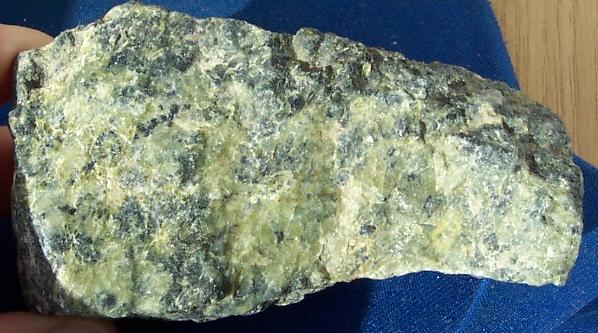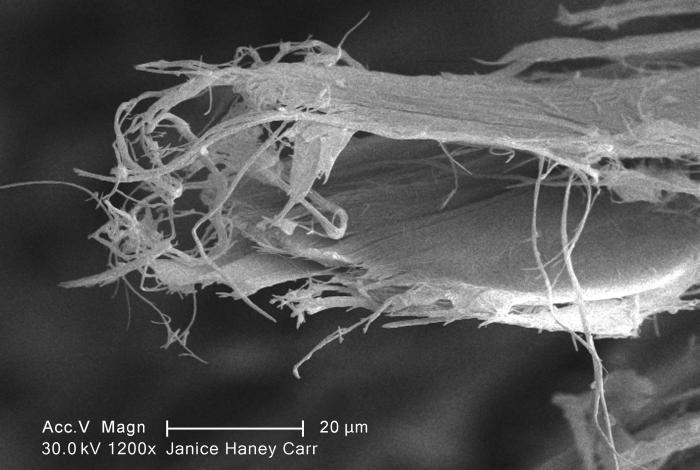|
Serpentinite
Serpentinite is a rock composed predominantly of one or more serpentine group minerals, the name originating from the similarity of the texture of the rock to that of the skin of a snake. Serpentinite has been called ''serpentine'' or ''serpentine rock'', particularly in older geological texts and in wider cultural settings.California Government Code § 425.2; ''see'' Formation and mineralogy Serpentinite is formed by near to complete serpentinization of mafic to ultramafic rocks. Serpentinite can be formed wherever ultramafic rock is infiltrated by water poor in carbon dioxide. This occurs at mid-ocean ridges and in the forearc mantle of subduction zones. The final mineral composition of serpentinite is usually dominated by lizardite, chrysotile, and magnetite. Brucite and antigorite are less commonly present. Lizardite, chrysotile, and antigorite all have approximately the formula or , but differ in minor components and in form. Accessory minerals, present in sm ... [...More Info...] [...Related Items...] OR: [Wikipedia] [Google] [Baidu] |
Serpentine Group
Serpentine subgroup (part of the kaolinite-serpentine group in the category of phyllosilicates) are greenish, brownish, or spotted minerals commonly found in serpentinite. They are used as a source of magnesium and asbestos, and as decorative stone. The name comes from the greenish colour and smooth or scaly appearance from the Latin , meaning "serpent rock". Serpentine subgroup is a set of common rock-forming hydrous magnesium iron phyllosilicate () minerals, resulting from the metamorphism of the minerals that are contained in mafic to ultramafic rocks. They may contain minor amounts of other elements including chromium, manganese, cobalt or nickel. In mineralogy and gemology, serpentine may refer to any of the 20 varieties belonging to the serpentine subgroup. Owing to admixture, these varieties are not always easy to individualize, and distinctions are not usually made. There are three important mineral polymorphs of serpentine: antigorite, lizardite and chrysotile. S ... [...More Info...] [...Related Items...] OR: [Wikipedia] [Google] [Baidu] |
Serpentinization
Serpentinization is a hydration and metamorphic transformation of ferromagnesian minerals, such as olivine and pyroxene, in mafic and ultramafic rock to produce serpentinite. Minerals formed by serpentinization include the serpentine group minerals (antigorite, lizardite, chrysotile), brucite, talc, Ni-Fe alloys, and magnetite. The mineral alteration is particularly important at the sea floor at tectonic plate boundaries. Formation and petrology Serpentinization is a form of low-temperature (0 to ~600 °C) metamorphism of ferromagnesian minerals in mafic and ultramafic rocks, such as dunite, harzburgite, or lherzolite. These are rocks low in silica and composed mostly of olivine (), pyroxene (), and chromite (approximately ). Serpentinization is driven largely by hydration and oxidation of olivine and pyroxene to serpentine group minerals (antigorite, lizardite, and chrysotile), brucite (), talc (Mg3Si4O10(OH)2, and magnetite (). Under the unusual chemical conditions acc ... [...More Info...] [...Related Items...] OR: [Wikipedia] [Google] [Baidu] |
Antigorite
Antigorite is a lamellated, monoclinic mineral in the phylosilicate serpentine subgroup with the ideal chemical formula of (Mg,Fe2+)3Si2O5(OH)4. It is the high-pressure polymorph of serpentine and is commonly found in metamorphosed serpentinites. Antigorite, and its serpentine polymorphs, play an important role in subduction zone dynamics due to their relative weakness and high weight percent of water (up to 13 weight % H2O). It is named after its type locality, the Geisspfad serpentinite, Valle Antigorio in the border region of Italy/ Switzerland and is commonly used as a gemstone in jewelry and carvings. Geologic occurrences Antigorite is found in low-temperature, high-pressure (or high-deformation) environments, including both extensional and compressional tectonic regimes. Serpentines are commonly found in the ultramafic greenschist facies of subduction zones, and are visible on the Earth's surface through secondary exhumation. Serpentinites that contain antigorite are u ... [...More Info...] [...Related Items...] OR: [Wikipedia] [Google] [Baidu] |
Chrysotile
Chrysotile or white asbestos is the most commonly encountered form of asbestos, accounting for approximately 95% of the asbestos in the United States Occupational Safety and Health Administration, U.S. Department of Labor (2007)29 C.F.R. 1910.1001 Appendix J. and a similar proportion in other countries.Institut national de recherche sur la sécurité (1997).Amiante." ''Fiches toxicologiques.'' n° 167. (in French) It is a soft, fibrous silicate mineral in the serpentine subgroup of phyllosilicates; as such, it is distinct from other asbestiform minerals in the amphibole group. Its idealized chemical formula is Mg( Si O)( OH). The material has physical properties which make it desirable for inclusion in building materials, but poses serious health risks when dispersed into air and inhaled. Polytypes Three polytypes of chrysotile are known. These are very difficult to distinguish in hand specimens, and polarized light microscopy must normally be used. Some older ... [...More Info...] [...Related Items...] OR: [Wikipedia] [Google] [Baidu] |
Subduction Zone
Subduction is a geological process in which the oceanic lithosphere is recycled into the Earth's mantle at convergent boundaries. Where the oceanic lithosphere of a tectonic plate converges with the less dense lithosphere of a second plate, the heavier plate dives beneath the second plate and sinks into the mantle. A region where this process occurs is known as a subduction zone, and its surface expression is known as an arc-trench complex. The process of subduction has created most of the Earth's continental crust. Rates of subduction are typically measured in centimeters per year, with the average rate of convergence being approximately two to eight centimeters per year along most plate boundaries. Subduction is possible because the cold oceanic lithosphere is slightly denser than the underlying asthenosphere, the hot, ductile layer in the upper mantle underlying the cold, rigid lithosphere. Once initiated, stable subduction is driven mostly by the negative buoyancy of th ... [...More Info...] [...Related Items...] OR: [Wikipedia] [Google] [Baidu] |
Lost City Hydrothermal Field
The Lost City Hydrothermal Field, often referred to simply as Lost City, is an area of marine alkaline hydrothermal vents located on the Atlantis Massif at the intersection between the Mid-Atlantic Ridge and the Atlantis Transform Fault, in the Atlantic Ocean. It is a long-lived site of active and inactive ultramafic-hosted serpentinization, abiotically producing many simple molecules such as methane and hydrogen which are fundamental to microbial life. As such it has generated scientific interest as a prime location for investigating the origin of life on Earth and other planets similar to it. Expedition history The Lost City was first identified on December 4, 2000, using ''DSV Alvin'' and ''ROV ArgoII'' on cruise AT03-60 of the RV Atlantis. The cruise lasted 34 days, during which photographs and vent chimney samples were taken. The discovery of the Lost City prompted the National Science Foundation to fund a second, 32-day voyage (AT07-34) to the site in 2003 in order to ... [...More Info...] [...Related Items...] OR: [Wikipedia] [Google] [Baidu] |
Ophiolite
An ophiolite is a section of Earth's oceanic crust and the underlying upper mantle that has been uplifted and exposed above sea level and often emplaced onto continental crustal rocks. The Greek word ὄφις, ''ophis'' (''snake'') is found in the name of ophiolites, because of the superficial texture of some of them. Serpentinite especially evokes a snakeskin. The suffix ''lite'' from the Greek ''lithos'' means "stone". Some ophiolites have a green color. The origin of these rocks, present in many mountainous massifs, remained uncertain until the advent of plate tectonic theory. Their great significance relates to their occurrence within mountain belts such as the Alps and the Himalayas, where they document the existence of former ocean basins that have now been consumed by subduction. This insight was one of the founding pillars of plate tectonics, and ophiolites have always played a central role in plate tectonic theory and the interpretation of ancient mountain bel ... [...More Info...] [...Related Items...] OR: [Wikipedia] [Google] [Baidu] |
Ecological Island
An ecological island is a term used in New Zealand, and increasingly in Australia, to refer to an area of land (not necessarily an actual island) isolated by natural or artificial means from the surrounding land, where a natural micro-habitat exists amidst a larger differing ecosystem. In New Zealand the term is used to refer to one of several types of nationally protected areas. In artificial ecological islands (also known as mainland islands): * all non-native species (at least predator species) have been eradicated, * native species are reintroduced and nurtured, and * the natural or artificial border is maintained to prevent reintroduction of non-native species. The ultimate goal is to recreate an ecological microcosm of the country as a whole as it was before human arrival. There is usually provision for controlled public access, and scientific study and research. The definition does not include land within a fence erected to: * protect farm animals from wild predators * pr ... [...More Info...] [...Related Items...] OR: [Wikipedia] [Google] [Baidu] |
Acetyl-CoA
Acetyl-CoA (acetyl coenzyme A) is a molecule that participates in many biochemical reactions in protein, carbohydrate and lipid metabolism. Its main function is to deliver the acetyl group to the citric acid cycle (Krebs cycle) to be oxidized for energy production. Coenzyme A (CoASH or CoA) consists of a β-mercaptoethylamine group linked to the vitamin pantothenic acid (B5) through an amide linkage and 3'-phosphorylated ADP. The acetyl group (indicated in blue in the structural diagram on the right) of acetyl-CoA is linked to the sulfhydryl substituent of the β-mercaptoethylamine group. This thioester linkage is a "high energy" bond, which is particularly reactive. Hydrolysis of the thioester bond is exergonic (−31.5 kJ/mol). CoA is acetylated to acetyl-CoA by the breakdown of carbohydrates through glycolysis and by the breakdown of fatty acids through β-oxidation. Acetyl-CoA then enters the citric acid cycle, where the acetyl group is oxidized to carbon dioxid ... [...More Info...] [...Related Items...] OR: [Wikipedia] [Google] [Baidu] |
New Caledonia
) , anthem = "" , image_map = New Caledonia on the globe (small islands magnified) (Polynesia centered).svg , map_alt = Location of New Caledonia , map_caption = Location of New Caledonia , mapsize = 290px , subdivision_type = Sovereign state , subdivision_name = , established_title = Annexed by France , established_date = 24 September 1853 , established_title2 = Overseas territory , established_date2 = 1946 , established_title3 = Nouméa Accord , established_date3 = 5 May 1998 , official_languages = French , regional_languages = , capital = Nouméa , coordinates = , largest_city = capital , demonym = New Caledonian , government_type = Devolved parliamentary dependency , leader_title1 = President of France , leader_name1 = Emmanuel Macron , leader_title2 = President of the Government , leader_name2 = Louis Mapou , leader_title3 = President of the Congress , leader_name3 = Roch Wamytan , leader_title4 = High Commissioner , leader_name4 = ... [...More Info...] [...Related Items...] OR: [Wikipedia] [Google] [Baidu] |





